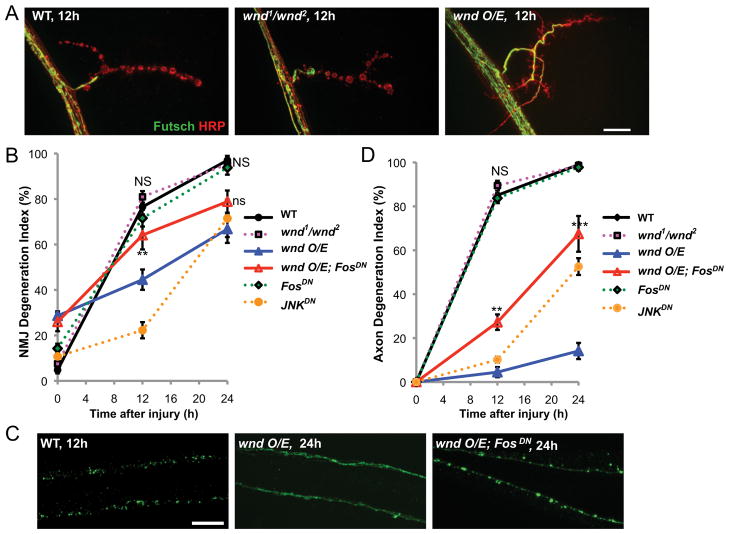Figure 2.
The Wallenda/DLK kinase inhibits Wallerian degeneration. A, Representative muscle 4 NMJs are shown for wild-type (Canton S), wnd mutant (wnd1/wnd2), and overexpressed wnd (BG380-Gal4; UAS-wnd/+) 12 h after injury. B, Quantification of the NMJ degeneration index (defined by absence of Futsch staining) over a time course for different genotypes. wnd mutant (magenta) and Fos DN (BG380;;UAS-Fos DN/+; green) degenerate with a similar time course as wild-type axons. NS, No significant difference from wild-type. However, overexpression of wnd (blue) dramatically delays degeneration. This inhibition of degeneration is strongly reduced when Fos DN is coexpressed (BG380;UAS-wnd/+; UAS-Fos DN/+; red). **p <0.01, compared with wnd O/E. An additional phenotype of wnd overexpression is a reduction of Futsch in terminal boutons, which results in a higher degeneration index in uninjured animals. However, this phenotype is not suppressed by coexpression of Fos DN. C, Representative images of single axons in wild-type axons (UAS-mCD8::GFP/+; m12-Gal4/+) that degenerated within 12 h of injury, compared with axons that remained intact 24 h after injury when wnd was overexpressed (UAS-wnd/UAS-mCD8::GFP; m12-Gal4/+). This protection from degeneration is inhibited by coexpression of Fos DN (UAS-wnd/UAS-mCD8::GFP; m12-Gal4/UAS-Fos DN). D, Quantification of axon degeneration in different genotypes. **p <0.01, ***p <0.001 compared with wnd O/E. Scale bars, 25 μm.

